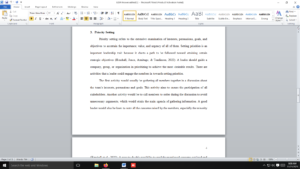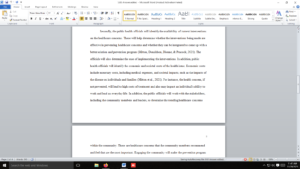Non-health professionals
This assignment is meant to address the CEPH competencies: Perform effectively on interprofessional teams. Using a current, real life environmental problem, you will connect with professionals outside public health to understand the role each discipline can provide in addressing this problem. Professionals may include: engineers, urban planners, business leaders, bankers, politicians, teachers, community activists etc. You must “meet” with the professional (by phone, zoom or email) and present the environmental problem. Then extract their unique disciplinary perspective on the problem and potential short term and long-term solutions.
STEP 1: Familiarize yourself with the global environmental issue of Recycling used lead-acid (automobile) batteries (ULABs)
STEP 2: Assemble a team of 3 Professionals (not affiliated with public health or medicine)
STEP 3: Present the problem to Professionals and solicit interventions based on specifically on theirdiscipline
STEP 4: Prepare “Interprofessional Team Report” Select 3 professions outside public health and medicine (see suggestions below).
For each profession, present ideas on various interventions in addressing the problem of the informal recycling of used lead-acid (automotive) batteries. You are encouraged to reach out to people in these professions and solicit their ideas. You will, of course, have to describe the problem and issues so please learn about this before you reach out. You are permitted to work in groups, but the report must come from each individual.
The Issue and Problem: Informal ULAB Recycling Lead-acid automotive and storage batteries are a very important commodity with an ever-expanding global market. Due to their simple construction and components; namely lead, acid and plastic, they approach a global recycling rate of almost 99%. As a result, many informal ULAB recyclers collect batteries, break them apart, melt/smelt the lead and resell it (see references below). This activity could be a family buying and processing a few batteries a week to provide a source of income or larger backyard smelters which process dozens or hundreds of automotive batteries. Unfortunately, the informal recycling process is dirty and contaminates families and communities. The published scholarship on this subject is quite extensive (see YouTubes, websites and listed above).
The Assignment: 5 Interview a team of non-health professionals and explore options to reduce lead poisoning from informal battery recycling activities. But keep in mind that ULAB activities worldwide provide needed sustenance for millions of struggling families in low- and middle-income countries. So simply banning informal ULABs may not be the best option. Each discipline will likely approach this problem from a different angle and your assignment is to describe their approaches. Lastly, please advise your “professionals” that banning LAB is not an option.
Submission: The report should integrate the interventions into a single coherent approach (if possible) and present the challenges in satisfying each intervention. It must also include a section on the lesson’s learned in working on interprofessional (interdisciplinary) teams. The report could be written (at least 1,500 words). It must be well sectioned and referenced. The flow should be as follows: 1. Presentation of health risks associated problems 2. Professional #1 approach 3. Professional #2 approach 4. Professional #3 approach 5. Assessment of the various approaches and lesson learned Possible Professions to choose from: (you may choose family, friends, colleagues) Advocacy Group, Banker, Ecologist / Biologist, Elected official / Mayor / Council Member, Engineer (civil or mechanical), International development officer, Labor Minister, Law Enforcement Officer, Politician, Teacher, Urban planner. Resources to learn about ULABs: YOUTUBE VIDEOS:
READINGS: UNICEF/Pure Earth, The Toxic Truth: Children’s Exposure to Lead Pollution Undermines a Generation of Future Potential, August 2020, https://www.pureearth.org/wp-
Haefliger, P., Mathieu-Nolf, M., Lociciro, S., Ndiaye, C., Coly, M., Diouf, A., Faye, A.L., Sow, A., Tempowski, J., Pronczuk, J. and Junior, A.P.F., 2009. Mass lead intoxication from informal used lead-acid battery recycling in Dakar, Senegal. Environmental Health Perspectives, 117(10), pp.1535-1540.
Tian, X., Gong, Y., Wu, Y., Agyeiwaa, A. and Zuo, T., 2014. Management of used lead acid battery in China: Secondary lead industry progress, policies and problems. Resources, conservation and recycling, 93, pp.75-84 WEBSITES: Pure Earth – www.pureearth.org, UN Env Program – www.unenvironment.org/explore-
Requirements: APA | Research Paper | 3 pages, Single spaced
This assignment is super important to me so please read every sentence of the proposal carefully and write this paper!
For the “It must also include a section on the lesson’s learned in working on interprofessional (interdisciplinary) teams” in the proposal, I’ll try to submit the pdf of that session asap
Answer preview
Such health issues are not only localized in Senegal, considering environmental and health experts have identified numerous other instances spread out across the world but predominantly restricted in developing countries. An example is the Dominican Chernobyl of the late 1990s, a case that also involved acute lead poisoning and affected numerous residents of Bajos de Haina in the Dominican Republic (Fuller, 2009). These residents were living next to an abandoned used lead-acid car battery recycling plant. The majority of health risks associated with handling these batteries emanate from exposure to lead. It is among the most useful but also very poisonous heavy metals ever discovered. Exposure to lead is harmful to human well-being irrespective of their age. However, studies show lead exposure is more toxic to children than adults.
[2039 Words]

Non-health professionals




